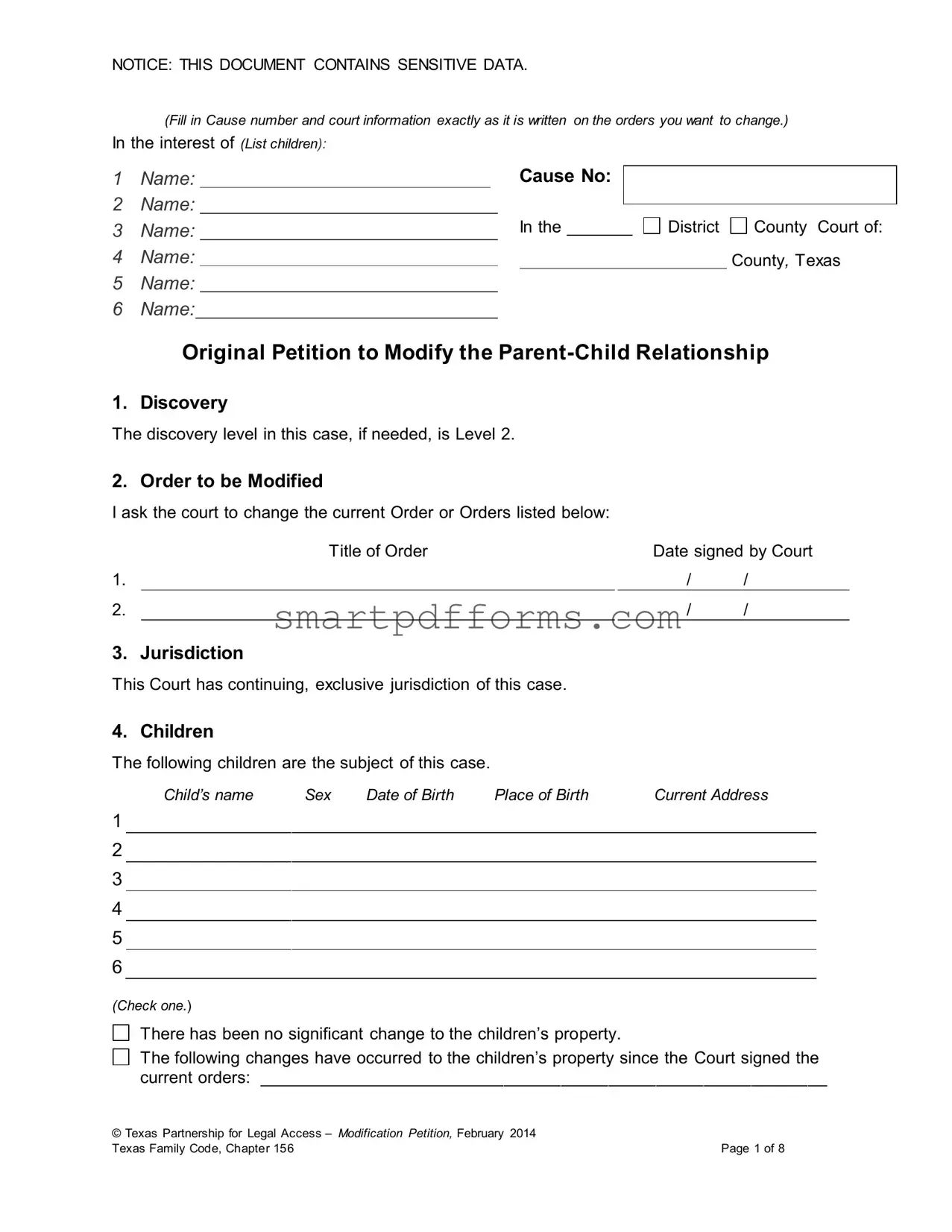NOTICE: THIS DOCUMENT CONTAINS SENSITIVE DATA.
(Fill in Cause number and court information exactly as it is written on the orders you want to change.)
In the interest of (List children):
1 |
Name: |
|
|
Cause No: |
|
2 |
Name: |
|
|
|
|
|
|
In the _______ |
3 |
Name: |
|
|
|
|
|
|
4Name:
5 Name:
6 Name:
District 
 County Court of: County, Texas
County Court of: County, Texas
Original Petition to Modify the Parent-Child Relationship
1. Discovery
The discovery level in this case, if needed, is Level 2.
2. Order to be Modified
I ask the court to change the current Order or Orders listed below:
|
Title of Order |
|
Date signed by Court |
1. |
|
|
/ |
/ |
2. |
|
|
/ |
/ |
3. |
Jurisdiction |
|
|
|
|
This Court has continuing, exclusive jurisdiction of this case. |
|
4. |
Children |
|
|
|
|
The following children are the subject of this case. |
|
|
|
Child’s name |
Sex |
Date of Birth |
Place of Birth |
Current Address |
1
2
3
4
5
6
(Check one.)
There has been no significant change to the children’s property.

 The following changes have occurred to the children’s property since the Court signed the current orders: ____________________________________________________________
The following changes have occurred to the children’s property since the Court signed the current orders: ____________________________________________________________
© Texas Partnership for Legal Access – Modification Petition, February 2014 |
|
Texas Family Code, Chapter 156 |
Page 1 of 8 |
5. Parties
Petitioner
My name is _________________________________________________________________.
I am the Petitioner, the person asking the Court to change the order or orders listed below.
The last three numbers of my driver’s license number are: ___ |
___ |
___. My driver’s license |
was issued in (State) ________________________. |
|
|
or |
I do not have a driver’s license number. |
|
|
The last three numbers of my social security number are: ___ |
___ |
___. |
or |
I do not have a social security number |
|
|
I live at _____________________________________________________________________.
Street Address |
City |
State |
Zip |
I am the children’s (Check one.) |
|
|
|
Sole Managing Conservator.
Possessory Conservator.
Joint Managing Conservator.
______________________________.
I have standing to bring this suit.
Respondents / People Entitled to Legal Notice
You MUST give legal notice of this case to each person named as a party in the current orders and anyone else whose rights may be affected by this case.
You MUST give legal notice of this case to the Office of the Attorney General, Child Support Division if:
●you are asking to change child support or medical support orders and
●the Office of the Attorney General is named as a party in the current orders or the child or anyone on behalf of the child receives or has received TANF, Food Stamps, or Medicaid.
Respondent A
Respondent A’s name is ____________________________________________________.
(PRINT the Respondent A’s full name)
Respondent A lives at _______________________________________________________.
Street Address |
City |
State |
Zip |
Respondent A is the children’s (Check one.) |
|
|
|
Sole Managing Conservator. |
Joint Managing Conservator. |
|
|
Possessory Conservator. |
______________________________. |
|
Legal Notice to Respondent A (Check one.)
Do not send a sheriff, constable, or process server to give a copy of this Petition to Respondent A, at this time. I think Respondent A will sign a Waiver of Service, or voluntarily file an Answer.
I will have a sheriff, constable, or process server give a copy of this Petition to Respondent A
here: ____________________________________________________________________
Street Address |
City |
State |
Zip |
© Texas Partnership for Legal Access – Modification Petition, February 2014 |
|
|
Texas Family Code, Chapter 156 |
|
|
Page 2 of 8 |
If this is a work address, name of business: ______________________________________
I ask the clerk to issue the citation of service. I understand that I will need to pay the fee (or file the form to show the Court that I am unable to pay the fee) and arrange for service.
Check this box if there is no Respondent B, and skip to number 6.
Respondent B’s name is___________________________________________________.
Respondent B lives at __________________________________________________________.
Street Address |
City |
State |
Zip |
Respondent is the children’s (Check one.) |
|
|
|
Sole Managing Conservator. |
Joint Managing Conservator. |
|
|
Possessory Conservator. |
______________________________. |
|
Legal Notice to Respondent B (Check one.)
Do not send a sheriff, constable, or process server to give a copy of this Petition to Respondent B at this time. I think Respondent B will sign a Waiver of Service, or voluntarily file an Answer.
I will have a sheriff, constable, or process server give a copy of this Petition to Respondent
B here: ___________________________________________________________________
Street AddressCityState Zip
If this is a work address, name of business: ______________________________________
I ask the clerk to issue the citation of service. I understand that I will need to pay the fee (or file the form to show the Court that I am unable to pay the fee) and arrange for service.
Check this box if there is no Respondent C, and skip to number 6.
Respondent C’s name is: __________________________________________________.
Respondent C lives at: _________________________________________________________.
Street Address |
City |
State |
Zip |
Respondent is the children’s (Check one.) |
|
|
|
Sole Managing Conservator. |
Joint Managing Conservator. |
|
|
Possessory Conservator. |
______________________________. |
|
Legal Notice to Respondent C (Check one.)
Do not send a sheriff, constable, or process server to give a copy of this Petition to Respondent C at this time. I think Respondent C will sign a Waiver of Service, or voluntarily file an Answer.
I will have a sheriff, constable, or process server give a copy of this Petition to Respondent
C here: ___________________________________________________________________
Street AddressCityState Zip
If this is a work address, name of business: ______________________________________
I ask the clerk to issue the citation of service. I understand that I will need to pay the fee (or file the form to show the Court that I am unable to pay the fee) and arrange for service.
© Texas Partnership for Legal Access – Modification Petition, February 2014 |
|
Texas Family Code, Chapter 156 |
Page 3 of 8 |
6. Information Required if a Party Lives Out-of-State
(Check one.)
Everyone involved in this case lives in Texas.
Someone involved in this case (one of the Respondents or me) does not live in Texas. (You must complete and attach Exhibit: Out-of-State Party Affidavit. This is required by Texas Family Code Section 152.209.)
7. Modifications (Changes) Requested
The circumstances of the children, a conservator, or other party affected by the order or orders to be modified have materially and substantially changed since the judge announced the prior order or orders.
The requested modifications are in the best interest of the children.
The requested modifications will change the following parts of the current orders:
7a. Changes to Conservatorship (Custody)
(Check one.)
I do not want to change the conservatorship (custody) orders. (If you choose this box, skip to 7b.)
I ask the Court to change the conservatorship (custody) orders as follows:
I ask the Court to change the conservatorship order to name me: (Check one.)
Joint Managing Conservator, with the exclusive right to establish the children’s primary residence, (Home-Parent),
Joint Managing Conservator, noncustodial parent, (Co-Parent)
Joint Managing Conservator, with a geographic restriction on where the children’s
primary residence will be located and neither parent having the exclusive right to establish the children’s primary residence.
Sole Managing Conservator, (Home-Parent)
Possessory Conservator, (Co-Parent)
and name Respondent: (Check one for each Respondent, if applicable. Circle the Respondent’s letter. )
AB C 
 Joint Managing Conservator, with the exclusive right to establish the children’s primary residence, (Home-Parent).
Joint Managing Conservator, with the exclusive right to establish the children’s primary residence, (Home-Parent).
AB C  Joint Managing Conservator, noncustodial parent, (Co-Parent).
Joint Managing Conservator, noncustodial parent, (Co-Parent).
AB C  Joint Managing Conservator, with a geographic restriction on where the children’s primary residence will be located and neither parent having the exclusive right to establish the children’s primary residence.
Joint Managing Conservator, with a geographic restriction on where the children’s primary residence will be located and neither parent having the exclusive right to establish the children’s primary residence.
AB C  Sole Managing Conservator, (Home-Parent).
Sole Managing Conservator, (Home-Parent).
AB C  Possessory Conservator (Co-Parent).
Possessory Conservator (Co-Parent).
(Check one, if applicable.)
© Texas Partnership for Legal Access – Modification Petition, February 2014 |
|
Texas Family Code, Chapter 156 |
Page 4 of 8 |

 I ask the Court to place a geographic restriction on where the children’s primary residence can be located.
I ask the Court to place a geographic restriction on where the children’s primary residence can be located.
I ask the Court to change the geographic restriction on where the children’s primary residence can be located.
I ask the Court to lift the geographic restriction on where the children’s primary residence can be located.
(Check, only if applicable.)
I am asking the Court to change the person who has the exclusive right to designate the children’s primary residence, and it has been less than one year since the order or
settlement agreement was signed. (You must complete and attach Exhibit: Petitioner’s Supporting Affidavit for Modification of Home (Custodial) Parent in Less than One Year of Order.)
7b. Changes to Right and Duties (Check one.)
I do not want to change orders regarding parental rights and duties. (Skip to 7c.)
I ask the Court to change orders regarding parental rights and duties to the following:
M om alone Dad alone M om and Dad |
Either |
Other |
together |
M om or Dad |
person* |
1.Make decisions concerning the children’s education
2.Consent to major medical, dental,
and surgical treatment for the child/ren
3.Consent to psychological treatment for the child/ren
4. Consent to a child’s marriage
5.Consent to a child enlisting in the U.S. Armed Forces
6.Manage or control the earnings or services of a child who works
7.Represent the child in a legal action
and make important legal decisions that affect the child
8. Make decisions for the children about their estates if required by law (unless the child has a guardian ad litem or guardian of the estate)
9.Manage the children’s estates if any
were created by the parents’ community or joint property.
© Texas Partnership for Legal Access – Modification Petition, February 2014 |
|
Texas Family Code, Chapter 156 |
Page 5 of 8 |
* If you checked “Other person,” on the above chart, explain below:
Name of other person: _____________________________________
Relationship to child/ren: ___________________________________
7c. Changes to Possession or Access (Visitation)
(Check one.)
I do not want to change possession or access (visitation) orders. (Skip to 7d.)
I ask the Court to change the possession and access orders to the following:
(Check all that apply.)
Standard visitation, with Petitioner (Home-Parent) having possession and access awarded to a parent with the exclusive right to designate the children’s primary
residence, and with Respondent A B C (Co-Parent) having possession and access awarded to a non-custodial parent.
Standard visitation, with Respondent A B C (Home-Parent) having possession and access awarded to a parent with the exclusive right to designate the children’s
primary residence, and with Petitioner (Co-Parent) having possession and access awarded to a non-custodial parent.
Other (Describe)
© Texas Partnership for Legal Access – Modification Petition, February 2014 |
|
Texas Family Code, Chapter 156 |
Page 6 of 8 |
7d. Changes to Child Support (Check one.)
I do not want to change child support orders. (Skip to 7e.)
I ask the Court to change the child support orders as follows: (Check all that apply. Circle respondent’s letter)
reducing the amount of child support Petitioner pays each month. increasing the amount of child support Petitioner pays each month.
reducing the amount of child support Respondent |
A B C |
pays each month. |
increasing the amount of child support Respondent |
A B C |
pays each month. |
Other (Describe.) |
|
|
|
|
|
|
|
|
|
|
|
|
|
|
|
|
|
|
|
|
|
|
|
|
|
|
7e. Changes to Medical Support (Check one.)
I do not want to change medical support orders. (Skip to 8.)
I ask the Court to change the medical support orders as follows: (Check all that apply.)
reducing the amount of medical support Petitioner pays each month. increasing the amount of medical support Petitioner pays each month.
reducing the amount of medical support Respondent A B |
C |
pays each month. |
increasing the amount of medical support Respondent A |
B C |
pays each month. |
ordering Petitioner to provide health insurance. |
|
|
ordering Respondent A B C to provide health insurance.

 Other: (Describe)
Other: (Describe)
© Texas Partnership for Legal Access – Modification Petition, February 2014 |
|
Texas Family Code, Chapter 156 |
Page 7 of 8 |
8.Children’s Health Insurance.
do not have private health insurance in effect.
Private Health Insurance is in effect: (Complete, if the children have private health insurance.)
Name of insurance company: __________________________________________________
Policy number: ______________________________________________________________
Cost of premium: $___________________________________________________________
Name of person who pays for insurance: __________________________________________
The insurance policy |
is |
is not available through the parent’s work. |
Private Health Insurance NOT in effect: (Complete, if the children do NOT have private health insurance.)
do not |
receive medical assistance through CHIPS or Medicaid. |
Cost of premium (if any): $_________________________________________________
Health insurance reasonable cost.
is not available to the person who pays child support at a
9. Information Required By Section 105.006
(Check one.)
I will include in the final Order, the social security and driver’s license numbers, current addresses, and phone numbers for each party and child who is subject to this suit, as required by section 105.006 of the Texas Family Code.
I ask the Court’s permission not to disclose the social security and driver’s license numbers, current address, and telephone numbers in the Final Order because providing that information is likely to cause the child or a conservator harassment, abuse, serious harm, or injury.
10. Prayer
I ask that citation and notice issue as required by law and that the Court make the other orders I have asked for in this Petition and any other orders to which I am entitled.
I ask for general relief.
Respectfully submitted,
Petitioner, Pro Se (Sign your name on the line.)
(PRINT your name and information.):
Name:Telephone:
Mailing Address:
Email Address:
Petitioner’s Fax #
(if available):
Attachment(s) included with this Petition (Check all that apply):
Exhibit Out-of-State Party Affidavit
Exhibit Petitioner’s Supporting Affidavit Modification of Home (Custodial) Parent in Less than One Year of Order
© Texas Partnership for Legal Access – Modification Petition, February 2014 |
|
Texas Family Code, Chapter 156 |
Page 8 of 8 |



 County Court of: County
County Court of: County





 Joint Managing Conservator, with the exclusive right to establish the
Joint Managing Conservator, with the exclusive right to establish the  Joint Managing Conservator, noncustodial parent,
Joint Managing Conservator, noncustodial parent,  Joint Managing Conservator, with a geographic restriction on where the
Joint Managing Conservator, with a geographic restriction on where the  Sole Managing Conservator,
Sole Managing Conservator,  Possessory Conservator
Possessory Conservator 

 I ask the Court to place a geographic
I ask the Court to place a geographic 



